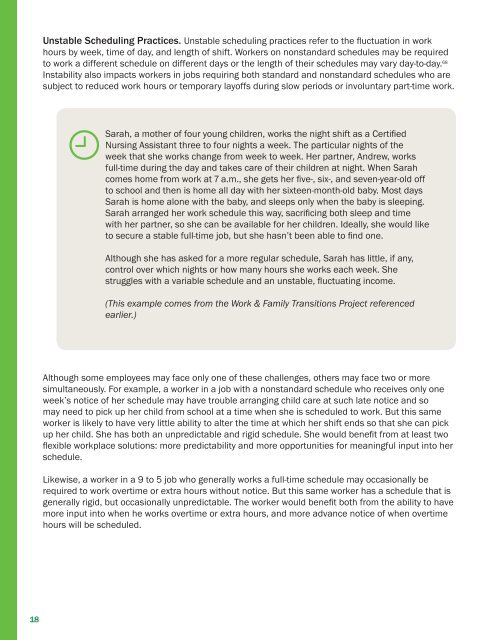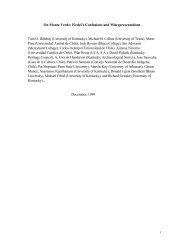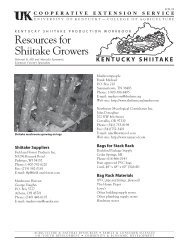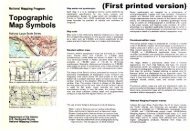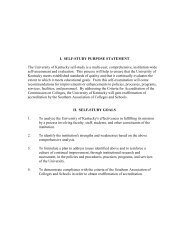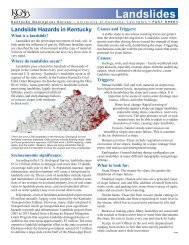Flexible Workplace Solutions for Low-Wage Hourly Workers
Flexible Workplace Solutions for Low-Wage Hourly Workers
Flexible Workplace Solutions for Low-Wage Hourly Workers
Create successful ePaper yourself
Turn your PDF publications into a flip-book with our unique Google optimized e-Paper software.
Unstable Scheduling Practices. Unstable scheduling practices refer to the fl uctuation in work<br />
hours by week, time of day, and length of shift. <strong>Workers</strong> on nonstandard schedules may be required<br />
to work a different schedule on different days or the length of their schedules may vary day-to-day. 68<br />
Instability also impacts workers in jobs requiring both standard and nonstandard schedules who are<br />
subject to reduced work hours or temporary layoffs during slow periods or involuntary part-time work.<br />
Sarah, a mother of four young children, works the night shift as a Certifi ed<br />
Nursing Assistant three to four nights a week. The particular nights of the<br />
week that she works change from week to week. Her partner, Andrew, works<br />
full-time during the day and takes care of their children at night. When Sarah<br />
comes home from work at 7 a.m., she gets her fi ve-, six-, and seven-year-old off<br />
to school and then is home all day with her sixteen-month-old baby. Most days<br />
Sarah is home alone with the baby, and sleeps only when the baby is sleeping.<br />
Sarah arranged her work schedule this way, sacrifi cing both sleep and time<br />
with her partner, so she can be available <strong>for</strong> her children. Ideally, she would like<br />
to secure a stable full-time job, but she hasn’t been able to fi nd one.<br />
Although she has asked <strong>for</strong> a more regular schedule, Sarah has little, if any,<br />
control over which nights or how many hours she works each week. She<br />
struggles with a variable schedule and an unstable, fl uctuating income.<br />
(This example comes from the Work & Family Transitions Project referenced<br />
earlier.)<br />
Although some employees may face only one of these challenges, others may face two or more<br />
simultaneously. For example, a worker in a job with a nonstandard schedule who receives only one<br />
week’s notice of her schedule may have trouble arranging child care at such late notice and so<br />
may need to pick up her child from school at a time when she is scheduled to work. But this same<br />
worker is likely to have very little ability to alter the time at which her shift ends so that she can pick<br />
up her child. She has both an unpredictable and rigid schedule. She would benefi t from at least two<br />
fl exible workplace solutions: more predictability and more opportunities <strong>for</strong> meaningful input into her<br />
schedule.<br />
Likewise, a worker in a 9 to 5 job who generally works a full-time schedule may occasionally be<br />
required to work overtime or extra hours without notice. But this same worker has a schedule that is<br />
generally rigid, but occasionally unpredictable. The worker would benefi t both from the ability to have<br />
more input into when he works overtime or extra hours, and more advance notice of when overtime<br />
hours will be scheduled.<br />
18


